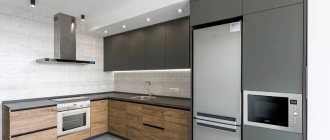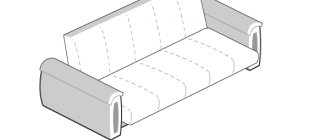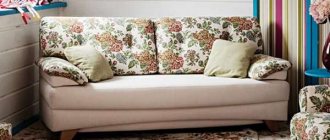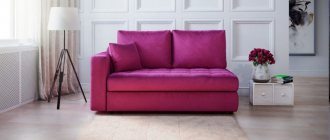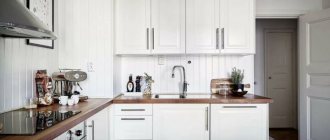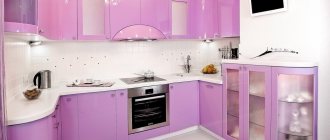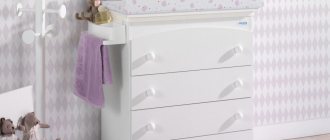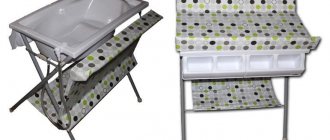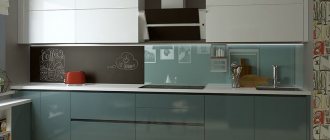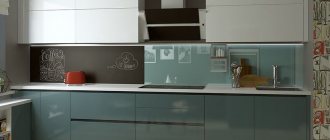The concept of “ideal kitchen” will be different for each housewife. Some prefer strict forms and discreet colors, while others prefer an abundance of decor, elaborate elements and original solutions. But every housewife values functionality and convenience.
Therefore, when choosing a kitchen set, the practicality of storage systems, which are cabinets, is assessed. They should not only be spacious and have a sufficient number of shelves, but also be easy to open, providing quick access to the necessary kitchen equipment.
Manufacturers offer innovative solutions - kitchens “without handles”. We propose to consider in more detail how practical and relevant this is.
Features of “handleless” kitchens
Kitchens without handles have been in demand on the market for about 5 years. Handle-free facades are more relevant than ever. Today, convenience and functionality come first when designing kitchens. Yes, they require the installation of additional elements - mechanisms, electric drives, but the cost for this convenience is now quite acceptable.
The beveled edge of the facade with a special recess, the so-called milled facade, can even be found in Ikea.
Surprisingly, facades with hidden handles, or without them at all, save time spent in the kitchen. Even if you have dough on your hands, you can open drawers with just one push of your elbow or knee. Built-in handles delicately emphasize the minimalism of the kitchen.
Combination with wallpaper and curtains
It is better to buy wallpaper that is washable, moisture-resistant, and does not change color from sunlight. Paintable canvases that can be painted several times are considered a good option. For white facades, any monochromatic version is suitable. With a large area, a kitchen without handles can even be black and white. Purple and dark blue wallpapers are also suitable.
In a small room, the walls can be light orange, gray, or blue. Country style involves animal and plant motifs. The minimalism style does not include images on the wallpaper.
For a white kitchen without handles with a wooden countertop, wooden blinds are suitable. The combination of white and brown is allowed in any style. Laconic Japanese curtains can also be considered a good option.
In addition to wallpaper and curtains, accessories and decorative elements are required:
- dishes;
- towels;
- serving textiles;
- stands;
- lighting;
- Wall Clock.
Indoor plants are perfect for decorating a kitchen with a white gloss texture with handleless wood.
Types of fittings systems
There are two completely concealed opening hardware systems:
- TIP-ON from Blum;
- Push-to-open from Hettich.
To open the cabinet, light pressure on the front is required. Closing is also carried out by slightly pressing the facade. Systems are offered that even independently close the door.
The Push-to-open system can be of two types: electrically driven and mechanical. You can also find cheaper analogues on the market. However, experts recommend choosing fitting systems from these particular manufacturers. Their products perform well, are of high quality and will ensure the durability and reliability of a handleless kitchen.
Analysis of the trend: Kitchen without handles - is it worth the investment?
Design:
suitable for minimalism and modern style, as well as kitchens in the style of Scandinavian countries and modern Italian neoclassicism.
Any smooth matte and glossy facades, facades with dark and light stone or wood finishes look good without handles.
Not suitable:
for paneled facades, classic and retro kitchens
Functional
- The “tip-on” or “push-to-open” system opens doors and pulls out drawers by pressing. You can do this with your fingers, the back of your hand (when your hands are dirty or busy), or even just your knee.
- The mortise handles (armholes that are made directly into the facades) and Gola profiles that are screwed to the upper edge of the facade are long and comfortable. There is no need to grope for the handle - just pull the profile in any convenient place (this can be done automatically, without looking).
- Clothing, the edges of an apron or towels do not catch or tear on the handles.
- It is easier to maintain the cleanliness of such a set: we wipe the facades one way or another every day or every other day - at least lightly walk over them with a damp cloth, because splashes fly during cooking.
But rubbing overhead handles until they shine is a topic for general cleaning. So, aggressive kitchen contaminants accumulate on the handles themselves and around them over time. So it turns out that a kitchen without handles requires less maintenance effort.
- A set without handles is safer (especially in small kitchens) - there is less risk of bumping (families with children especially appreciate this).
Important: kitchens with bracket handles may be inconvenient for girls who are used to wearing long nails. To be sure of your choice, visit the Kitchen Factory showroom and test different types of opening.
Reliability
- Gola mortise handles or profiles do not break, do not unscrew and last 10-15 years longer than usual. In addition, there is no situation where the handle will spoil the facade over time (a known problem in kitchens of the 2000s).
- Push-to-open systems open and close doors and drawers silently - so the hinges will last longer, and you will be less tired of extraneous sounds.
Price
- Gola profiles and handles are inexpensive and have virtually no effect on the final price of the kitchen
- Mortise handles (when recesses are made in the facades that can be pulled), as well as push-to-open systems increase the price by 3-9%, depending on the complexity of the design and the manufacturer of the fittings (the most reliable are European Blum and Hettich).
What should you pay attention to?
In most cases, it is better to combine different types of openings in the kitchen.
Topmost, third row of cabinets
Always opens upwards using gas lifts. It is not recommended to install handles here in any form. When opened, such a door rises to the very ceiling. The handle will hit the ceiling and leave marks, and if the ceiling is suspended, the canvas will instantly tear.
Therefore, if you have a kitchen up to the ceiling, be sure to order the top row with a push-to-open mechanism.
Middle row of cabinets
He doesn't need pens either. If you make the fronts a few millimeters longer, it will be convenient to open the cabinets simply by the edge. This is also the most economical option
If desired, medium cabinets can also be equipped with push-pull opening or designed to open upwards with folding - convenient for tall dish storage systems.
Important: If you free the middle row of cabinets from handles, and leave the bottom row with handles, the kitchen will not lose functionality, but will look more laconic and neat. This option is suitable for those who do not want to spend money on expensive European systems for opening the lower rows, but also do not like to overload the interior.
Drawers, built-in refrigerator and lower line of cabinets
A combination of systems can be used here. Make the drawers open when pressed (it’s easy to get to the contents even if your hands are full), but handles are a must for the dishwasher and built-in refrigerator.
The fact is that dishwashers have very strong springs - according to safety standards. To avoid breaking your nails and accidentally hitting yourself, it is better if the dishwasher opens using a traditional handle.
The shot below shows that the kitchen, where most of the cabinets are without handles, and only the dishwasher and refrigerator with handles, looks light, stylish and modern.
It is convenient to use a dishwasher with profile handles that are attached to the top of the fronts. If the kitchen is under dark stone, they are almost invisible, but only add soft plasticity and graphics to the set.
Quote from the designer of "Kitchen
Advantages and disadvantages of a “handleless” kitchen
The “handleless” kitchen solution has undeniable advantages and some disadvantages that should be taken into account when choosing.
Pros:
- ease of cleaning cabinets - many experienced people know how difficult it is to clean a kitchen with chamfers, and even with long handles;
- visual restraint of facades in form for lovers of the minimalist style and for kitchens and living rooms - they visually lighten the space;
- the absence of handles saves space and allows you not to cling to them, which is especially important in narrow kitchens;
- this solution is relevant for corner kitchens, since it completely eliminates the possibility of damage to adjacent facades when opening corner cabinets;
- opening by lightly pressing the door;
- There are many options - there is sure to be a mechanism suitable for the price;
- The contents of drawers or cabinets are accessible even when your hands are full.
Minuses:
- it is necessary to install additional electric drives and mechanisms;
- Touch marks remain on the surface of the furniture, especially if the facades are glossy. However, removing fingerprints on doors is much easier than cleaning classic-style handles;
- specific opening assumes incomplete adherence to the furniture body, since backlash is necessary for correct operation.
Method 2. Play with the shape of the kitchen facade without a handle, pros and cons
The handle on the kitchen facade does not necessarily have to be attached to the front surface. It can be integrated into the facade itself and not “give” itself away.
The role of a handle can be played by a profile fixed at the end.
Or a special recess running along the entire length of the facade.
The handle can be mortise, recessed into the facade.
Each of these methods has its own advantages. The main thing is that no other opening mechanisms are needed. In fact, the door will open in the same way by grabbing the handle. It just won't be noticeable at all.
Of the minuses, it is worth noting that a handle can be integrated into any facade. And the choice of decors, the price range is sharply limited by the possible options. As does the choice to integrate handles into the façade to achieve the desired effect.
Advice from the professionals
When deciding to install a “handleless” kitchen, choose light shades - for example, blue-gray, light gray, white and beige. On a light surface, marks from frequent touches will be less visible. The surface itself should be matte, satin, slightly rough or semi-glossy. Perhaps the least practical option for such a solution is a black glossy kitchen.
Kitchens without handles. Photo
Do you like handleless kitchens?
Recommendations for selection
The first and foremost thing you need to know about handleless kitchens is that the options suit ultra-modern styles.
In a modern, hi-tech or minimalist interior, such kitchen sets will look best. In classic or country cuisine - strange and inappropriate. 3 tips will help you avoid mistakes:
- Focus on light and matte facades. They are more practical and get dirty less than dark and glossy ones.
- Don’t give up on grab handles throughout your kitchen—it’s more convenient to open a built-in refrigerator or dishwasher using a familiar bracket or rail.
- Combine systems to create the most functional kitchen possible. It is convenient to open the upper hinged cabinets by pressing, and the lower drawers using profiles or embedded handles.
